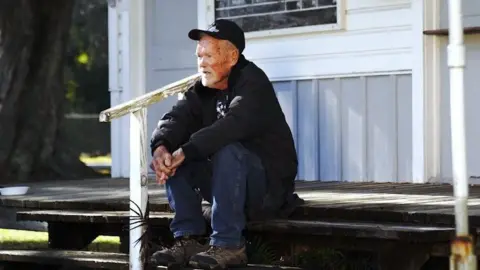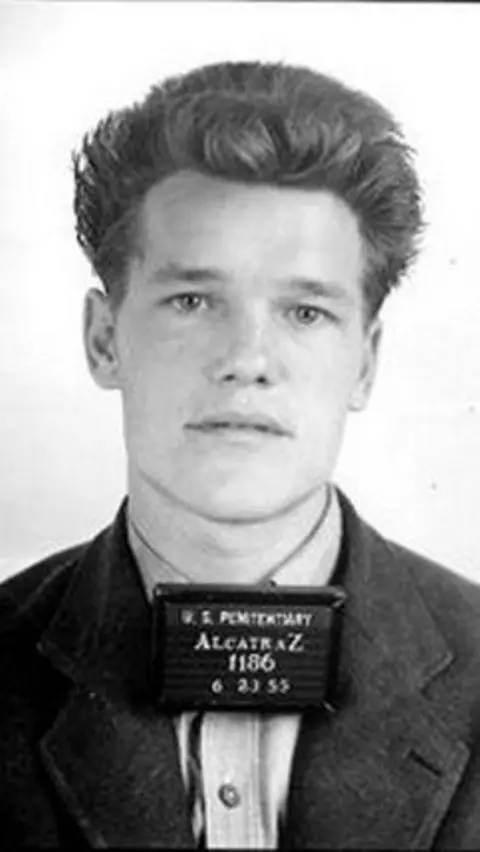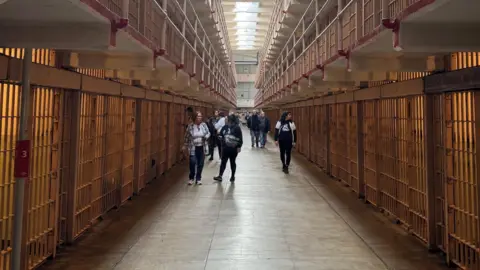One of Alcatraz's last living inmates on Trump's plan to reopen prison
 Daniel A. Edwards
Daniel A. EdwardsWhen Charlie Hopkins thinks back to the three years he spent in one of America's most famous prisons, he remembers the "deathly quiet" the most.
In 1955, Hopkins was sent to Alcatraz - a famed prison on an isolated island off the coast of San Francisco - after causing trouble at other prisons to serve a 17-year sentence for kidnapping and robbery.
Falling asleep at night in his cell on the remote island, he said, the only sound was the whistle of ships passing.
"That's a lonely sound," Hopkins said. "It reminds you of Hank Williams singing that song, 'I'm so lonesome I could cry.'"
Now 93 and living in Florida, Hopkins said the San Francisco National Archives informed him that he is likely the last surviving former Alcatraz inmate. The BBC could not independently verify this.
In an interview with the BBC this week, Hopkins described life at Alcatraz - which formed the setting for the 1996 film The Rock - where he made friends with gangsters and once helped plan an unsuccessful escape.
Although it closed decades ago, US President Donald Trump recently claimed that he wants to re-open it as a federal prison.
When Hopkins was transferred to the high-security prison in 1955, from an Atlanta facility, he remembers it being clean, but barren. And there were few distractions - no radio at the time, and few books, he said.
"There was nothing to do," he said. "You could walk back and forth in your cell or do push-ups."
Hopkins kept busy part of the time with his job cleaning Alcatraz, sweeping the floors and buffing them "until they shined", he said.
He was sent to prison in 1952 in Jacksonville, Florida, for his role in a series of robberies and kidnappings. He was part of a group that took hostages to get through roadblocks and steal cars, he said.
 National Archives
National ArchivesAt Alcatraz, Hopkins had some infamous neighbours. The facility housed many violent criminals over its 30 years - Al Capone; Robert Stroud, a murderer known as the "Birdman of Alcatraz"; and crime boss James "Whitey" Bulger - making it the subject of a host of films and television shows.
A 22-acre island, 1.25 miles (2km) off San Francisco and surrounded by freezing waters with strong currents, Alcatraz was originally a naval defence fort. It was rebuilt in the early 20th century as a military prison. The US Justice Department took it over in the 1930s, transforming the facility into a federal prison to address rampant organised crime at the time.
Even in the high-security prison, Hopkins said he still managed to get into trouble and spent many days in the facility's "D Block" - solitary confinement where inmates who misbehaved were held and rarely let out of their cells.
His longest stint there - six months - came after he tried to help several other prisoners, including notorious bank robber Forrest Tucker, escape Alcatraz, Hopkins said. He helped steal hacksaw blades from the prison's electric shop to cut the prison bars in the basement kitchen.
The plan didn't work - prison guards discovered the blades in other inmates' cells, Hopkins said. "A few days after they locked them up, they locked me up," he said.
But that did not stop one of the inmates.
In 1956, when Tucker was taken to a hospital for a kidney operation, he stabbed his ankle with a pencil so prison guards would have to remove his leg irons, Tucker told the New Yorker. Then, as he was taken to get an X-ray, he overpowered hospital orderlies and ran away, he said.
He was captured in a hospital gown in a cornfield hours later.
As more prisoners attempted to escape Alcatraz over the years, officials ramped up security, Hopkins said.
"When I left there in 1958, the security was so tight you couldn't breathe," he said.
All told, there were 14 separate attempts over the years involving 36 inmates, according to the National Park Service.
One of the most famous involved Frank Morris, and brothers Clarence and John Anglin, who escaped in June 1962 by placing papier-mâché heads in their beds and breaking out through ventilation ducts. They were never found, but the FBI concluded that they drowned in the cold waters surrounding the island.
A year later, the prison shut down after the government determined it would be more cost-effective to build new prisons than to keep the remote island facility in operation.
Now it's a publicly run museum visited by millions each year that generates about $60m (£45m) a year in revenue for park partners.
The building is decrepit, with peeling paint, rusted pipes, and crumbling toilets in each cramped cell. Construction on the main prison facility began in 1907, and more than a century of exposure to the elements has rendered the place all but uninhabitable.
Trump said this week, however, that he wants his government to re-open and expand the island prison for the country's "most ruthless and violent offenders".

Alcatraz "represents something very strong, very powerful" - law and order, Trump said.
But experts and historians said Trump's proposal to re-establish the prison is far-fetched, as it would cost billions to repair and bring up to date with other federal facilities.
Hopkins agrees. "It would be so expensive," he said.
"Back then, the sewage system went into the ocean," he added. "They'd have to come up with another way of handling that."
Hopkins left Alcatraz five years before it closed down for good. He had been transferred to a prison in Springfield, Missouri and given psychiatric medication that improved his behaviour and helped him heal psychological issues, he said.
But the avid Trump supporter said he does not believe the president's proposal is serious.
"He don't really want to open that place," Hopkins said, adding that Trump was trying to "get a point across to the public" about punishing criminals and those who enter the US illegally.
Hopkins was released in 1963, working first at a truck stop before taking on other jobs. He went back to his home state of Florida, where now he has a daughter and grandson.
After several decades reflecting on his crimes and life in Alcatraz, he wrote a 1,000-page memoir, with nearly half of the book detailing his troubled behaviour, he said.
"You wouldn't believe the trouble I caused them when I was there," he said. "I can see now, looking back, that I had problems."
